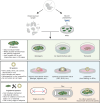Approaches to benchmark and characterize in vitro human model systems
- PMID: 36214410
- PMCID: PMC10906492
- DOI: 10.1242/dev.200641
Approaches to benchmark and characterize in vitro human model systems
Abstract
In vitro human models, such as gastruloids and organoids, are complex three-dimensional (3D) structures often consist of cells from multiple germ layers that possess some attributes of a developing embryo or organ. To use these models to interrogate human development and organogenesis, these 3D models must accurately recapitulate aspects of their in vivo counterparts. Recent advances in single-cell technologies, including sequencing and spatial approaches, have enabled efforts to better understand and directly compare organoids with native tissues. For example, single-cell genomic efforts have created cell and organ atlases that enable benchmarking of in vitro models and can also be leveraged to gain novel biological insights that can be used to further improve in vitro models. This Spotlight discusses the state of current in vitro model systems, the efforts to create large publicly available atlases of the developing human and how these data are being used to improve organoids. Limitations and perspectives on future efforts are also discussed.
Keywords: Cell atlas; Human development; Model systems.
© 2022. Published by The Company of Biologists Ltd.
Figures

Similar articles
-
Carnegie in 4D? Stem-cell-based models of human embryo development.Semin Cell Dev Biol. 2022 Nov;131:44-57. doi: 10.1016/j.semcdb.2022.05.023. Epub 2022 Jun 11. Semin Cell Dev Biol. 2022. PMID: 35701286 Review.
-
Charting human development using a multi-endodermal organ atlas and organoid models.Cell. 2021 Jun 10;184(12):3281-3298.e22. doi: 10.1016/j.cell.2021.04.028. Epub 2021 May 20. Cell. 2021. PMID: 34019796 Free PMC article.
-
Translating Embryogenesis to Generate Organoids: Novel Approaches to Personalized Medicine.iScience. 2020 Sep 25;23(9):101485. doi: 10.1016/j.isci.2020.101485. Epub 2020 Aug 21. iScience. 2020. PMID: 32864586 Free PMC article. Review.
-
Capturing Cardiogenesis in Gastruloids.Cell Stem Cell. 2021 Feb 4;28(2):230-240.e6. doi: 10.1016/j.stem.2020.10.013. Epub 2020 Nov 10. Cell Stem Cell. 2021. PMID: 33176168 Free PMC article.
-
Self-assembled liver organoids recapitulate hepatobiliary organogenesis in vitro.Hepatology. 2018 Feb;67(2):750-761. doi: 10.1002/hep.29483. Epub 2018 Jan 2. Hepatology. 2018. PMID: 28834615 Free PMC article.
Cited by
-
Approaches to investigating metabolism in human neurodevelopment using organoids: insights from intestinal and cancer studies.Development. 2022 Oct 15;149(20):dev200506. doi: 10.1242/dev.200506. Epub 2022 Oct 18. Development. 2022. PMID: 36255366 Free PMC article.
-
Bridging systems biology and tissue engineering: Unleashing the full potential of complex 3D in vitro tissue models of disease.Biophys Rev (Melville). 2024 Apr 10;5(2):021301. doi: 10.1063/5.0179125. eCollection 2024 Jun. Biophys Rev (Melville). 2024. PMID: 38617201 Free PMC article. Review.
-
Nascent matrix deposition supports alveolar organoid formation from aggregates in synthetic hydrogels.Stem Cell Reports. 2025 Jan 14;20(1):102376. doi: 10.1016/j.stemcr.2024.11.006. Epub 2024 Dec 12. Stem Cell Reports. 2025. PMID: 39672155 Free PMC article.
-
Coordinated differentiation of human intestinal organoids with functional enteric neurons and vasculature.Cell Stem Cell. 2025 Apr 3;32(4):640-651.e9. doi: 10.1016/j.stem.2025.02.007. Epub 2025 Mar 4. Cell Stem Cell. 2025. PMID: 40043706
-
EPIREGULIN creates a developmental niche for spatially organized human intestinal enteroids.JCI Insight. 2023 Mar 22;8(6):e165566. doi: 10.1172/jci.insight.165566. JCI Insight. 2023. PMID: 36821371 Free PMC article.
References
-
- Aldinger, K. A., Thomson, Z., Phelps, I. G., Haldipur, P., Deng, M., Timms, A. E., Hirano, M., Santpere, G., Roco, C., Rosenberg, A. B.et al. (2021). Spatial and cell type transcriptional landscape of human cerebellar development. Nat. Neurosci. 24, 1163-1175. 10.1038/s41593-021-00872-y - DOI - PMC - PubMed
-
- Basil, M. C., Cardenas-Diaz, F. L., Kathiriya, J. J., Morley, M. P., Carl, J., Brumwell, A. N., Katzen, J., Slovik, K. J., Babu, A., Zhou, S.et al. (2022). Human distal airways contain a multipotent secretory cell that can regenerate alveoli. Nature 604, 120-126. 10.1038/s41586-022-04552-0 - DOI - PMC - PubMed
MeSH terms
Grants and funding
LinkOut - more resources
Full Text Sources

